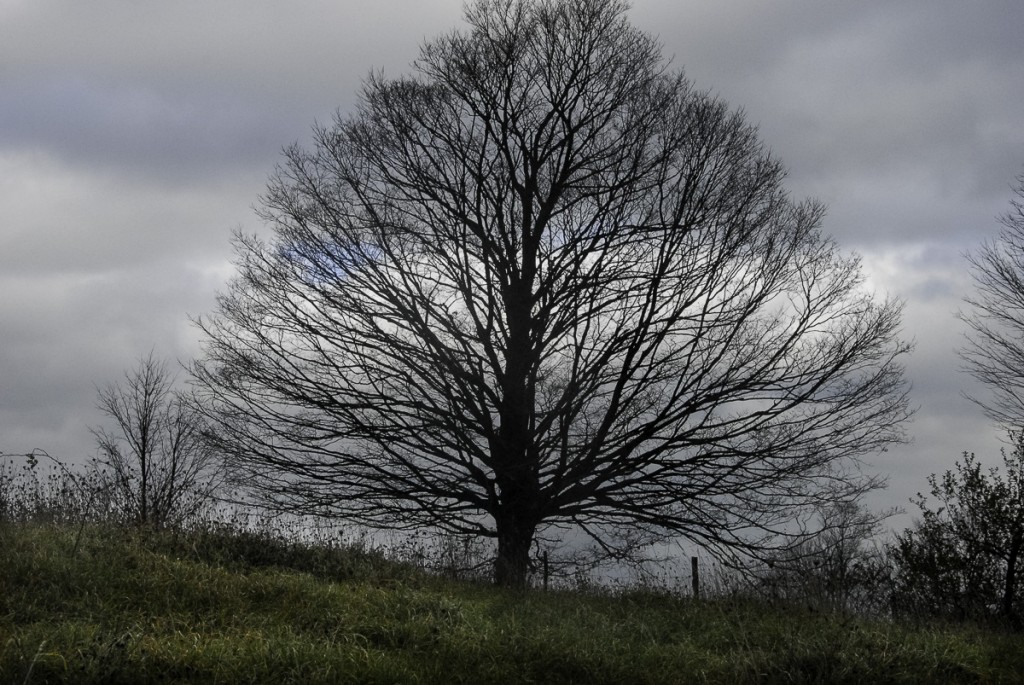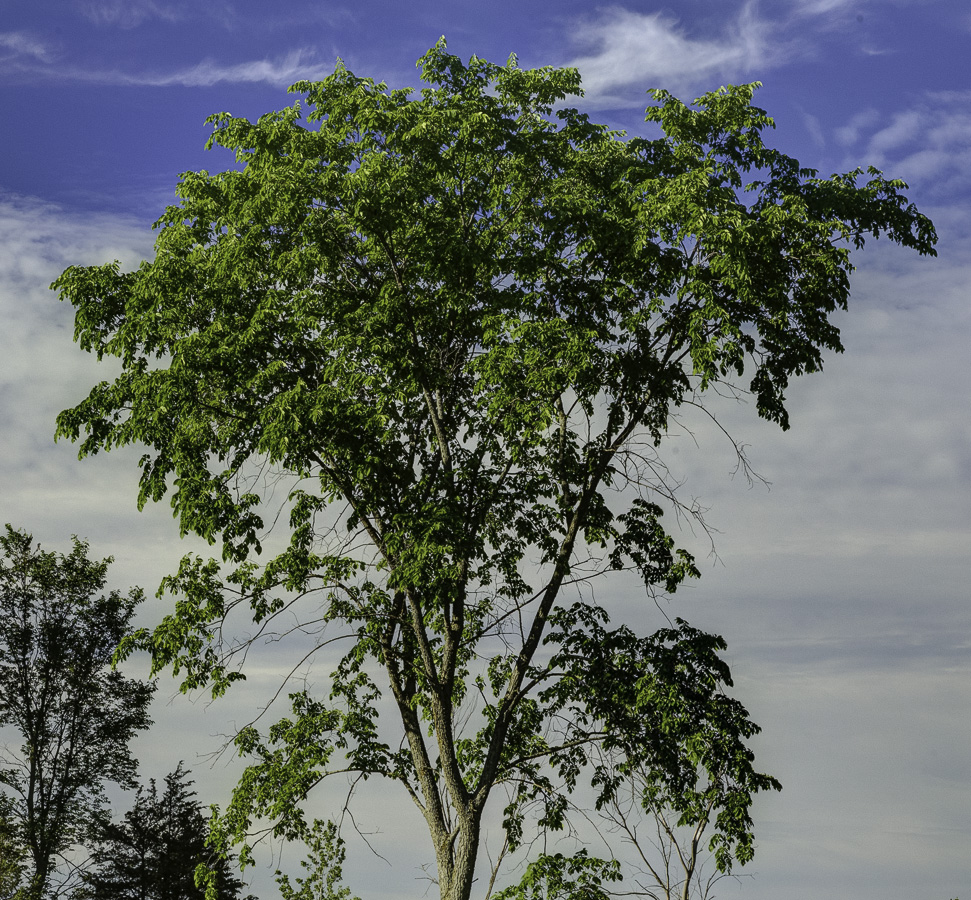Jerry Jenkins, White Creek, N.Y.
This is a blog about tree branches: what they look like, how they develop, how they differ between species, and how you can use them to identify trees in winter. It is not, however, about why oaks have one sort of branches and elms another. This makes me a bit sad, because it means that I can’t do something that once I hoped to do.
Briefly, the story is this. When I came to White Creek, my goal was to learn botany. I hunted plants in the summer and looked at trees in the winter. I wanted to learn to identify trees from branching patterns and to understand why different trees had different branches. I walked and skied, read whatever I could find, and filled notebooks with sketches and diagrams. Winter nights, raising a glass to Thompson and Hutchinson and MacArthur, I sat by the fire, wrote equations, and plotted graphs. I made some progress. Others—Henry Horn and Tom Givnish come to mind—made more. We thought, and I still think, that we knew why trees look like trees. We speculated, and I think interestingly, that certain kinds of branches fit with certain ecologies and life histories. But we lacked, and still lack, a theory of how branch patterns are generated and regulated. And lacking that, it was difficult to progress beyond speculation.
Nevertheless it was a wonderful time for me. I was 28 and had a new town to explore and new ideas to try out. This is the hill where I often started my walks. Back then it was mostly open pasture.
I spent about ten winters looking at trees and thinking about how patterns are created and what they might mean. In the process I learned a lot about trees that was not in any book. I tried several times to write this up. But each time I ran into problems.
Parts of the writing were easy. Many trees have distinctive branching patterns, and it was fun to name them and illustrate them. This white ash, Fraxinus americana, has a upswept, pinnate branches that make a broad, convergent, nonhierarchical crown.

Other parts were hard. I could name the patterns in this red oak (Quercus rubra: angular, segmental branches and wide angles in the terminal sprays) and recognize them from a distance. But I couldn’t explain why red oaks looked like this, or why maples didn’t. The the incompleteness of what I knew bothered me. I continued to look at tree branches and make drawings and diagrams, but didn’t write about them for thirty years.
Until, that is, a few weeks ago. I was walking, looking at the last oak leaves, and realized that while incompleteness no longer mattered much to me the beauty of trees mattered a lot. I had in my head a good story about tree branches. In the Atlas archives, I had the images and diagrams I needed to tell it. The beauty of trees might ultimately be mysterious, and hence hard to talk about. But for writers of a certain age, and I am definitely of that age, that is an incentive and not an excuse.
And so: start with the sugar maple, Acer saccharum. It is, like beech, yellow birch, hemlock, and white pine, one of the defining trees of the northern forest. Here is one from my yard, with flowers and new leaves.
The leaves are not throughout the tree but rather in a relatively thin outer shell of fine twigs. The main branches support the shell, and are are one of the keys to winter identification. The twigs are another. I look at the main branches in this blog, and the smaller shoots and twigs in the next.
To see the branches at their best, look at an open-grown tree at whole-tree scale, far enough away to see the outline and close enough to see the trunk and branches. If you are looking at pictures, remember that they flatten the tree, and branches angled toward or away from the camera look steeper than they are.
At this distance, there are four major features: the rounded outline, the trunk that breaks up into several near-vertical branches, the numerous side branches fanning out from the trunk and verticals, and the shell of fine twigs extending all the way down the sides. Additionally, most of the branches are either straight or, in the lower parts of the tree, somewhat upswept.
These features are common to many open-grown sugar maples. I call them the tree’s structure, and diagram them like this.
For analysis, I divide the branches into three groups: the verticals, the ones spreading radially just below them, and ones roughly parallel to each other long the sides. The branches actually grade into one another without sharp division but, as I will explain in later blogs, the grouping is a convenient way of recognizing basic structural plans. This plan, where the three groups grade evenly into each other, I call a radial plan.
Most open-grown sugar maples are generally similar: they have slender branches and fine twigs and look something like a small oval brush spread out between your fingers. The proportions of the brush vary. Here is an oblong one, taller relative to its height, and with lots of parallel branches along the sides. I would say that this tree is radial on the top and feather-like—pinnate—along the sides.
Here, a very common shape, is an oval one with a broad bottom and narrower crown, with upswept branches in the lower third. The leaning utility pole, still there, is the sort of thing we do well in White Creek.
In trees like this one the lowest main branches are quite strong and often form a hub. This is a characteristic feature of open-grown trees that is not seen in the woods.
Here, in a hedgerow, the trees resemble those in a forest, with narrower crowns and reduced lower branches.

What is important here is that sugar maples do not have a single shape. Rather, they have a plan for the apportionment of growth between vertical, radial, and parallel branches. Different maples apportion growth differently. The shape, branch angles, and branch weights change in response. Evolutionarily, it is some sort of mixture of variation and adaptation. Diagrammatically, it looks like this.
What is common to all of these variants is that the sugar maple is capable, depending on its situation, of growing at many different angles. In the open, the top grows fastest and the sides somewhat slower, generating the typical shape. But even so, all the major branches contribute to the expansion of the tree. Contrast this, for example, with this American elm, Ulmus americana, which privileges some branches and suppresses others.
This particular elm, in Lake Placid, is about as big as elms get today. It has a thinning crown and will die soon.
Returning to the sugar maple, we can turn our structure diagram into a growth diagram by adding arrows.
A subtle point in connection with growth directions is that the direction that the branch tip points in is not necessarily the direction that the branch grows in. Or, put another way, many trees have no difficulty making straight branches from bent twigs.
Here, for example, two red oak branches are growing relatively straight outwards, even though most of their twigs point up.
The construction of straight(ish) branches from bent twigs happens through two processes: downward flexing of the branch at the base, and segmentation, which is the replacement of an upward-angled leading twig by one of its side-twigs at a lower angle. A diagram looks like this.
Flexion is most common in trees with big long branches and is the reason many large, open-grown trees, like the swamp white oak, Quercus bicolor, spread widely. This one is from the Mississquoi River in Vermont.
Segmentation is common in many trees. In this male sumac, it is programmed: each year, the vertical branches flower and their tips abort. The following year, they are replaced by new branches from below the tip.
This generates a modular pattern that I call relay branching: each branch segment grows for a year and then is replaced by a branch below it.
In this butternut, the pattern is similar, but the program less rigid. A branch elongates rapidly for a year, turns up at its tip, and is continued by a side branch which, in turn, elongates, turns up, and is replaced. Like sumac, the pattern is modular and consists of a distinctive sequence of joints and swoops—think of the waves in a Japanese painting. The difference from sumac is that the turned up tips continue to grow vertically, though at a slower rate.
So still a relay, but one in which, rather than aborting after their lap, the branch tips continue in a different direction at a different speed.
These notions—modularity, relaying, branch and twig directions—are important, and we will be back to them. First, however, there are things to say about sugar maple twigs and bark. That comes next week.
But I am glad, finally, to have started. Let me know what you think.
Jerry Jenkins, White Creek, December 6, 2016.













Thank you Jerry! I am looking at trees with new eyes.
Thank Chris, always, and let me know what you see.
J.
Beautiful, insightful words and images, Jerry. You are teaching us deeper ways to view plants and their parts. You are elucidating mysteries. I look forward to further forest rambles with you. John D
Jerry, This is a very nice presentation on the mechanics of tree form. What triggers the tree to take on the forms – oval, elliptical, oblong, rounded, forest grown? Is it mechanical abrasion from neighbors and the resultant shape is an avoidance measure? Is it the “desire” to present as many leaves to light and to maximize light gathering efficiency? I think that where a tree grows is much up to chance…the chance occurrence of a viable seed falling on a place that is suitable for a particular species survival and growth. But its branching expression seems too ordered. They’re not just pushing out branches willy-nilly. There is rhyme and reason here…to the tree. Thanks.
This is all very interesting — I like especially how you’ve distinguished and given names to branches in different places, doing different things, in the sugar maples. Lately this has made me think again about the branching and leafing patterns from above — sunview — and below — mine, when I walk around the edges of the ponds in winter and look up, or into the sugar maples in summer. What do those patterns have to do with how they look from side views of whole-tree shape? How come the twigs of the yellow birches have that beautiful curve back in — staying out of the way of the neighbors while making a twig with rows of single leaves? Are the maples the only ones who fill the mosaic by making some leaves tiny in the center, and the lower ones with _really_ long stems? And so on — no end of questions for the trees!